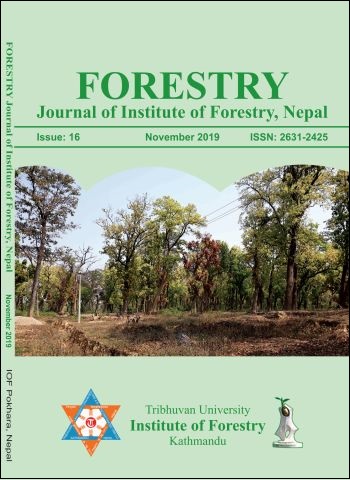Investigating Habitat Suitability and Conservation Issues of Re-introduced Wild Water Buffalo in Chitwan National Park, Nepal
DOI:
https://doi.org/10.3126/forestry.v16i0.28350Keywords:
Importance Value Index, vegetation analysis, suitable habitat, translocation, Saccharum spontaneum, viable populationAbstract
With an ever present threat of extinction aggravated mostly by inbreeding, genetic introgression and flooding stress, translocation of wild water buffalo (Bubalus arnee) to another suitable habitat was a must since decades. Habitat suitability analysis for wild water buffalo has been done by using binary model in ArcGIS 10.2.2 and slope, elevation, distance to water bodies and land cover criteria were used to prepare habitat suitability map of Chitwan National Park. Vegetation compositions were assessed in the grassland of Old Padampur area in sample plots (n = 36) each of size 1m x 1m for grasses and 10m x 10m for trees by using random sampling strategy. Conservation issues were identified through key-informant interviews and on-site observation of enclosure area, where re-introduced wild water buffalo were soft released. 127.13 km2 of the park area was identified as suitable habitat for wild water buffalo with around 79% of Old Padampur area. Importance Value Index (IVI) indicated that Saccharum spontaneum was found to be the most dominant grass species (IVI = 100.43) followed by Imperata cylindrica (IVI = 56.70) in Old Padampur area. Old Padampur area lies in the lap of Rapti River with many streams and marshes in the area which contributes to its suitability. The grassland of Old Padampur area is the largest in the park. At present, the wild water buffalo is facing some conservation issues mainly due to improper execution of soft release strategy and few uncontrolled natural events, such as floods and predators attacks. Therefore, to maintain the viable population of wild water buffalo in Chitwan National Park in the long-run, it is crucial to regulate and enhance effective soft release strategy and more advance techno-based modality in close coordination with conservation partners and relevant stakeholders.
Downloads
Downloads
Published
How to Cite
Issue
Section
License
© Tribhuvan University, Institute of Forestry




